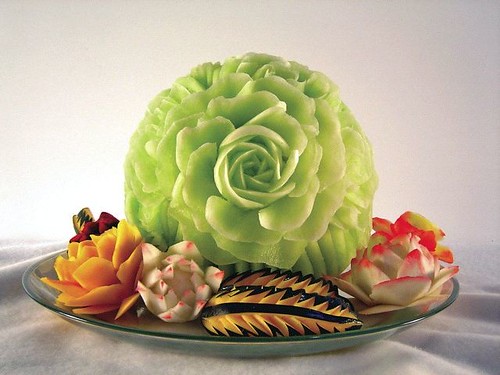name 'Welt der carving 'is taken from the German language with the purpose of being synonymous with 'world of carving '
Wednesday, 17 July 2013
Friday, 5 July 2013
Our First Lesson - Vegetable Carving
Types of vegetable cutting
- rose
- sunflower
- carnation
Rose
- buds (kudup)
- flower petals (kelopak)
- footstalk (tangkai)
- leaf (daun)
types of vegetables that we used: carrot and white radish.
*center point must be upright while looking to make shapes.
*to produce flower buds, the blade should be tilted.
*to trim: 45-degree blade
*to cut: 90-degree blade
Tuesday, 2 July 2013
History of Fruit and Vegetable Carving
The Origins
The origins of fruit and vegetable carving are disputed:
many people believe it to have begun in Sukothai, Thailand 700 years ago, while others believe that fruit and vegetable carving originated in the time of the Tang Dynasty and the Sung Dynasty in China. Or perhaps Japan is the root of the art of fruit and vegetable carving, called Mukimono in Japanese. According the book "Japanese Garnishes, The Ancient Art of Mukimono", by Yukiko and Bob Haydok, Mukimono's origins began in ancient times when food was served on unglazed clay pottery. These rough platters were covered with a leaf before the food was plated. Artistic chefs realized that the cutting or folding of the leaf in different ways created a more attractive presentation. Until the sixteenth century, street artists created clever garnishes upon request.
Whatever way fruit carving originated, it is now known and practiced worldwide. Fruit and vegetable carving is flaunted in many different Asian restaurants, cruises, hotels, and other various places.
References: wikipedia :)
Fruit Carving
fruit carving is the art of carving fruits to form beautiful objects, such as flowers.



Monday, 1 July 2013
The purpose of the blog was created
The purpose of this blog was created was to develop a site for the pursuit of knowledge in the field of culinary arts hospitality. This blog can be a guide for students to subjects HH620-Culinary Artistry. This blog exists to foster a competitive spirit among the students. In addition, to unearth the hidden talents among students.
Subscribe to:
Posts (Atom)



